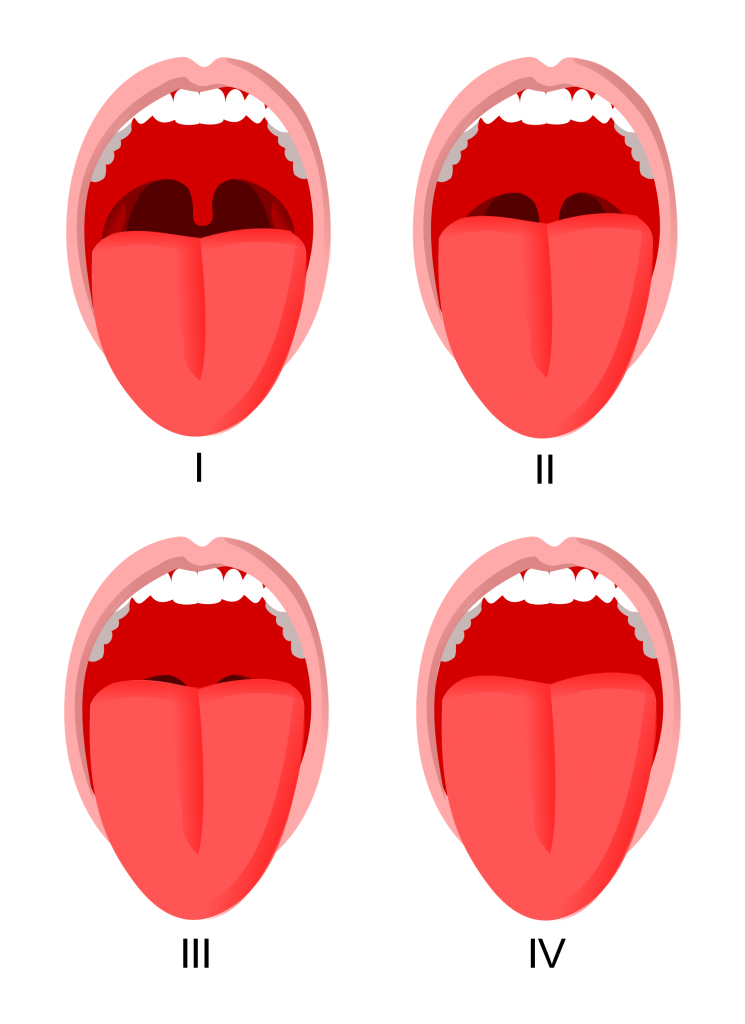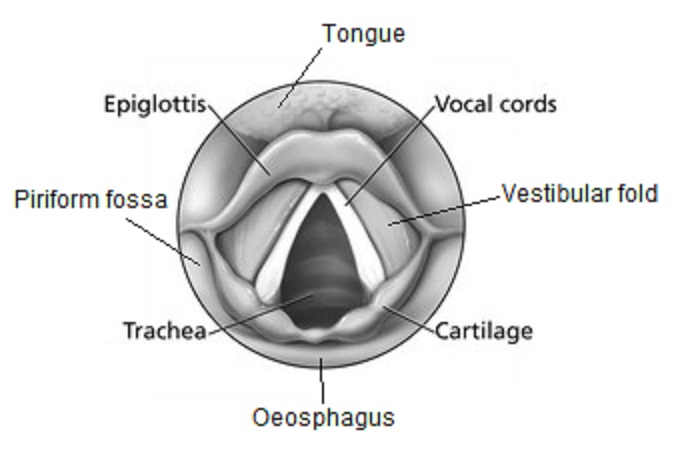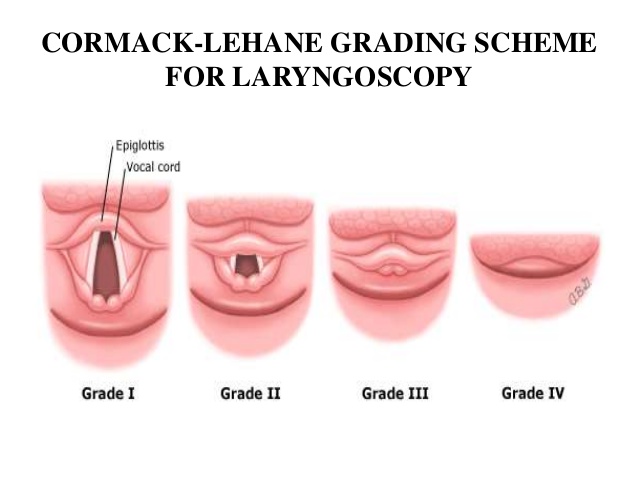.png)
Procedural Skills (SLO6)
You are working on your anaesthetics rotation and have been asked to perform an airway assessment on a patient due to undergo elective cholecystectomy later that day. Regarding airway assessment, which of the following statements is true?
Answer:
- Class III Mallampati classification - soft palate, base of uvula visible
- Grade I Cormack-Lehane classification: vocal cords are fully visible
- 3-3-2 rule: Distance between hyoid bone and chin should be at least 3 finger breadths (3)
- Difficult intubation is defined as when an experienced laryngoscopist, using direct laryngoscopy, requires:
- more than two attempts with the same blade or;
- a change in the blade or an adjunct to a direct laryngoscope e.g. bougie or;
- use of an alternative device or technique following failed intubation with direct laryngoscopy
- LEMON: N= neck mobility
Advanced Airway Management: Airway Assessment
Procedural Skills (SLO6)
Last Updated: 14th December 2023
During elective anaesthesia, a failed airway occurs in 0.01 - 0.03% of cases. A difficult intubation, occurs in 1.15 - 3.8% of cases. However, the characteristics of patients requiring intubation or assisted ventilation outside the operating room are different to those undergoing elective surgical procedures, and the incidence of difficult intubation is significantly higher in emergency departments. A failed airway may occur at least ten times more frequently in the emergency setting. Given this data, difficulties with the airway must be expected in all emergency patients and appropriate preparation undertaken. Some features may indicate a particularly high likelihood of airway difficulties, and in these cases, modification of practice may reduce complications and improve outcomes.
Definitions
A difficult airway is categorised by:
- Difficult mask ventilation
- Occurs when the patient's anatomy or injuries make it impossible to maintain adequate ventilation and oxygenation with a facemask and simple airway adjuncts alone
- Difficult intubation
- Defined when an experienced laryngoscopist, using direct laryngoscopy, requires:
- more than two attempts with the same blade or;
- a change in the blade or an adjunct to a direct laryngoscope e.g. bougie or;
- use of an alternative device or technique following failed intubation with direct laryngoscopy
- Defined when an experienced laryngoscopist, using direct laryngoscopy, requires:
- Difficult view at laryngoscopy
- Classified by Cormack and Lehane and defined as being unable to see any portion of the vocal cords with conventional laryngoscopy (Cormack and Lehane grades 3 and 4)
- Difficult cricothyroidotomy
- Failure to intubate the trachea combined with an inability to oxygenate the patient using a bag-mask or supraglottic airway device will necessitate a surgical airway. Occasionally, patient-specific features may render the cricothyroid membrane inaccessible. This makes induction of anaesthesia particularly risky because if the airway is lost it may be irretrievable and oxygenating the patient will be impossible.
General assessment
Pre-anaesthetic assessment of emergency patients where time allows:
- Comprehensive history
- Details of current condition
- Current medication and allergies
- Previous medical and surgical problems (including previous anaesthetics and any history of a difficult airway)
- Last oral intake
- Cardiorespiratory status
- Conscious level
- Focal/global neurological signs
- Assessment of face and neck
- Assessment for pneumothorax
- Abdominal and pelvic assessment for surgical signs
- Body morphology
Predicting difficult airways
The LEMON mnemonic can be used to remember how to assess for difficult intubation.
| LEMON | Assessment |
|---|---|
| Look |
|
| Evaluate the 3-3-2 rule |
|
| Mallampati score |
|
| Obstruction of airway |
|
| Neck mobility |
|
Mallampati classification
- Class I - Soft palate, uvula, fauces, pillars visible
- Class II - soft palate, uvula, fauces visible
- Class III - soft palate, base of uvula visible
- Class IV - hard palate only visible

Mallampati Classification. (Courtesy of Jmarchn (Own work) [CC BY-SA 3.0 (http://creativecommons.org/licenses/by-sa/3.0) or GFDL , via Wikimedia Commons)
View at direct laryngoscopy

View at Direct Laryngoscopy. (Via Wikimedia Commons)
Cormack and Lehane classification of view at direct laryngoscopy
- Grade I: vocal cords are fully visible
- Grade II: vocal cords are only partly visible
- Grade III: only epiglottis is seen
- Grade IV: epiglottis can't be seen

Cormack-Lehane Grading Scheme for Laryngoscopy. (Via Wikimedia Commons)
Report A Problem
Is there something wrong with this question? Let us know and we’ll fix it as soon as possible.
Loading Form...
- Biochemistry
- Blood Gases
- Haematology
| Biochemistry | Normal Value |
|---|---|
| Sodium | 135 – 145 mmol/l |
| Potassium | 3.0 – 4.5 mmol/l |
| Urea | 2.5 – 7.5 mmol/l |
| Glucose | 3.5 – 5.0 mmol/l |
| Creatinine | 35 – 135 μmol/l |
| Alanine Aminotransferase (ALT) | 5 – 35 U/l |
| Gamma-glutamyl Transferase (GGT) | < 65 U/l |
| Alkaline Phosphatase (ALP) | 30 – 135 U/l |
| Aspartate Aminotransferase (AST) | < 40 U/l |
| Total Protein | 60 – 80 g/l |
| Albumin | 35 – 50 g/l |
| Globulin | 2.4 – 3.5 g/dl |
| Amylase | < 70 U/l |
| Total Bilirubin | 3 – 17 μmol/l |
| Calcium | 2.1 – 2.5 mmol/l |
| Chloride | 95 – 105 mmol/l |
| Phosphate | 0.8 – 1.4 mmol/l |
| Haematology | Normal Value |
|---|---|
| Haemoglobin | 11.5 – 16.6 g/dl |
| White Blood Cells | 4.0 – 11.0 x 109/l |
| Platelets | 150 – 450 x 109/l |
| MCV | 80 – 96 fl |
| MCHC | 32 – 36 g/dl |
| Neutrophils | 2.0 – 7.5 x 109/l |
| Lymphocytes | 1.5 – 4.0 x 109/l |
| Monocytes | 0.3 – 1.0 x 109/l |
| Eosinophils | 0.1 – 0.5 x 109/l |
| Basophils | < 0.2 x 109/l |
| Reticulocytes | < 2% |
| Haematocrit | 0.35 – 0.49 |
| Red Cell Distribution Width | 11 – 15% |
| Blood Gases | Normal Value |
|---|---|
| pH | 7.35 – 7.45 |
| pO2 | 11 – 14 kPa |
| pCO2 | 4.5 – 6.0 kPa |
| Base Excess | -2 – +2 mmol/l |
| Bicarbonate | 24 – 30 mmol/l |
| Lactate | < 2 mmol/l |

